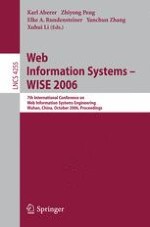2006 | Book
Web Information Systems – WISE 2006
7th International Conference on Web Information Systems Engineering, Wuhan, China, October 23-26, 2006. Proceedings
Editors: Karl Aberer, Zhiyong Peng, Elke A. Rundensteiner, Yanchun Zhang, Xuhui Li
Publisher: Springer Berlin Heidelberg
Book Series : Lecture Notes in Computer Science
